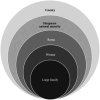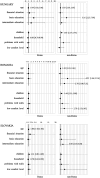Assessing disparities in health and living conditions: a comparative study of Hungarian-speaking Roma and non-Roma women across Hungary, Romania, and Slovakia
- PMID: 39234083
- PMCID: PMC11371694
- DOI: 10.3389/fpubh.2024.1438018
Assessing disparities in health and living conditions: a comparative study of Hungarian-speaking Roma and non-Roma women across Hungary, Romania, and Slovakia
Abstract
Background: The Roma minority, Europe's largest ethnic minority, experiences significant disparities in living conditions and health outcomes compared to the non-Roma populations across the continent. Despite extensive documentation of the socio-economic challenges faced by the Roma, there is a notable lack of comparative research.
Methods: This study aims to fill this gap by examining the differences in socio-economic characteristics, living conditions, and self-reported health status between Roma (R) and non-Roma (nR) women in in Hungary (HU), Romania (RO), and Slovakia (SK), providing a cross-country comparative analysis. Utilizing simple and multiple binary logistic models, our research analysed data collected from September 2020 to March 2022, involving 322 Roma and 294 non-Roma women in Hungary, 258 Roma and 183 non-Roma women in Romania, and 146 Roma and 163 non-Roma women in Slovakia.
Results: Findings indicate significant associations between increased age (R:OR = 1.04[1.02,1.06], p < 0.001), (nR:OR = 1.04[1.02,1.05], p < 0.001) lower financial situation (R:OR = 2.05[1.01,4.18], p = 0.048) (nR:OR = 1.67[1.01,2.77], p = 0.047), and basic education level (R:OR = 3.60[1.29,10.08], p = 0.015) (nR:OR = 3.64[1.77,7.51], p < 0.001) with the likelihood of poor health status across both groups in Hungary. In Romania, increased age (OR = 1.04[1.02,1.06], p < 0.001) and basic education level (OR = 5.24[2.29,11.99], p < 0.001) were particularly predictive of poor health among non-Roma, while in Slovakia, age (OR = 1.05[1.02,1.07], p < 0.001) was a significant factor for Roma, and intermediate education level (OR = 2.68[1.16,6.20], p = 0.021) was for non-Roma. The study also found that a higher number of children (HU:OR = 1.35[1.12,1.63], p = 0.002), (RO:OR = 1.57[1.25,1.96], p < 0.001) and problems with housing comfort (RO:OR = 4.83[2.19,10.62], p = 0.015) and wall conditions (RO:OR = 2.81[1.22,6.46], p < 0.001) significantly impacted the health status of non-Roma women in Hungary and Romania. Conversely, an increase in household size was associated with a better health status among Roma women in Hungary (OR = 0.88[0.79,0.99]) and Slovakia (OR = 0.78[0.61,0.99]).
Conclusion: By offering a novel comparative analysis, this study highlights the critical need for focused attention on the health disparities faced by Roma women, particularly those in a multiply disadvantaged situation due to their ethnic and socio-economic status.
Keywords: Roma women; comfort level; health; inequalities; living condition; vulnerable groups.
Copyright © 2024 Mózes, Takács, Ungvari and Feith.
Conflict of interest statement
The authors declare that the research was conducted in the absence of any commercial or financial relationships that could be construed as a potential conflict of interest.
Figures


Similar articles
-
Screening attendance disparities among Hungarian-speaking Roma and non-Roma women in central and eastern European countries.Front Public Health. 2023 Dec 22;11:1292598. doi: 10.3389/fpubh.2023.1292598. eCollection 2023. Front Public Health. 2023. PMID: 38186708 Free PMC article.
-
The socio-economic determinants of the health status of Roma in comparison with non-Roma in Bulgaria, Hungary and Romania.Eur J Public Health. 2010 Oct;20(5):549-54. doi: 10.1093/eurpub/ckq102. Epub 2010 Jul 22. Eur J Public Health. 2010. PMID: 20650945
-
[Comparative study of factors influencing cytological screening for cervical cancer attendance in Hungary among Roma and non-Roma population, in relation to Slovak and Romanian results].Orv Hetil. 2023 Sep 10;164(36):1416-1425. doi: 10.1556/650.2023.32842. Print 2023 Sep 10. Orv Hetil. 2023. PMID: 37695714 Hungarian.
-
Roma Health: An Overview of Communicable Diseases in Eastern and Central Europe.Int J Environ Res Public Health. 2020 Oct 20;17(20):7632. doi: 10.3390/ijerph17207632. Int J Environ Res Public Health. 2020. PMID: 33092048 Free PMC article. Review.
-
A systematic review of water, sanitation and hygiene among Roma communities in Europe: Situation analysis, cultural context, and obstacles to improvement.Int J Hyg Environ Health. 2020 May;226:113506. doi: 10.1016/j.ijheh.2020.113506. Epub 2020 Apr 1. Int J Hyg Environ Health. 2020. PMID: 32247253
Cited by
-
Dialogic scientific gatherings: promoting inclusive health participation and communication among non-academic Roma women.Front Public Health. 2025 Jul 10;13:1618150. doi: 10.3389/fpubh.2025.1618150. eCollection 2025. Front Public Health. 2025. PMID: 40709033 Free PMC article.
References
-
- European Commission . Roma equality, inclusion and participation in the EU (2020). Available at: https://commission.europa.eu/strategy-and-policy/policies/justice-and-fu.... (Accessed April 5, 2024).
-
- European Commission . Funding, strategy, facts and figures and contact details for national Roma contact points in Hungary (2023). Available at: https://commission.europa.eu/strategy-and-policy/policies/justice-and-fu.... (Accessed April 5, 2024).
Publication types
MeSH terms
LinkOut - more resources
Full Text Sources
Medical
Research Materials
Miscellaneous

